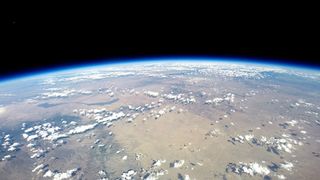
A near-space balloon company is about to take its fledgling test campaign to the next level.
Arizona-based World View, which aims to loft passengers to the stratosphere by late 2016, will start launching research and education payloads on its unmanned test flights later this year, company officials said.
"This is meant to show how serious we are," World View chief scientist and co-founder Alan Stern told Space.com. "We're not just talking about flying payloads. We're starting it ourselves."
World View — which launched its first test flight last month from New Mexico — has chosen three payloads that will collect data at altitudes as high as 120,000 feet (36,500 meters) during the test campaign, as part of a program the company is calling Pathfinder. These experiments, along with their home institutions and principal investigators, are:
- Meteor Imager, SETI (Search for Extraterrestrial Intelligence) Institute (Peter Jenniskens)
- Student Ozone Monitor, Florida Space Grant Consortium (Jaydeep Mukherjee)
- Stratospheric Automated Radiation Measurements for Aviation Safety, Space Environment Technologies (W. Kent Tobiska)
Each of these payloads may go up on multiple test flights, at no cost to their home institutions, Stern said.
World View is selling seats on its manned balloon system for $75,000. Customers will float up to an altitude of about 100,000 feet (30,500 m), where they'll get a stunning view of Earth against the blackness of space, company representatives have said. (Several other firms, including Virgin Galactic and XCOR Aerospace, are developing rocket-powered vehicles that will take passengers much higher, up into suborbital space.)
But World View isn't just about near-space tourism, Stern stressed. The company is also developing unmanned systems that will fly scientific and education payloads to the stratosphere and views such efforts as key to their business plan. (The unmanned June test flight employed one of these systems, which World View calls Tycho.)
Get the Space.com Newsletter
Breaking space news, the latest updates on rocket launches, skywatching events and more!
The research and education market "is going to be, we think, potentially even a larger market than the tourism side," Stern said.
Follow Mike Wall on Twitter @michaeldwall and Google+. Follow us @Spacedotcom, Facebook or Google+. Originally published on Space.com.
Join our Space Forums to keep talking space on the latest missions, night sky and more! And if you have a news tip, correction or comment, let us know at: community@space.com.

Michael Wall is a Senior Space Writer with Space.com and joined the team in 2010. He primarily covers exoplanets, spaceflight and military space, but has been known to dabble in the space art beat. His book about the search for alien life, "Out There," was published on Nov. 13, 2018. Before becoming a science writer, Michael worked as a herpetologist and wildlife biologist. He has a Ph.D. in evolutionary biology from the University of Sydney, Australia, a bachelor's degree from the University of Arizona, and a graduate certificate in science writing from the University of California, Santa Cruz. To find out what his latest project is, you can follow Michael on Twitter.
